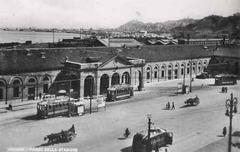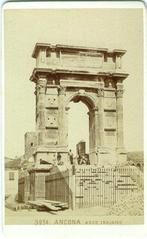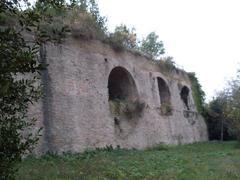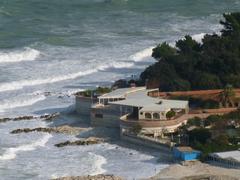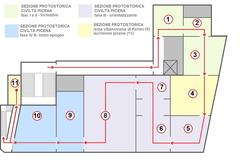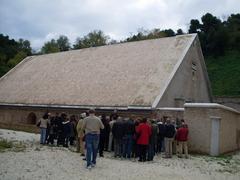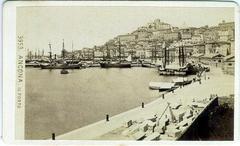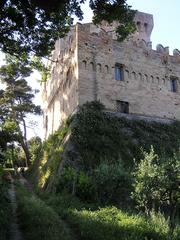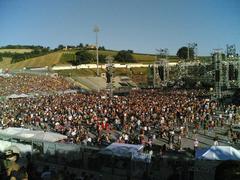Forte Scrima Ancona, Italy: Visiting Hours, Tickets, and Travel Guide
Date: 14/06/2025
Introduction: Fortress of History and Heritage
Rising above Ancona’s railway station in the Posatora district, Forte Scrima is a striking 19th-century fortress that embodies Italy’s military heritage and Ancona’s strategic maritime significance. Built between 1861 and 1866 as part of a defensive network designed by military architect Giuseppe Morando, the fort is renowned for its unique “butterfly” bastioned layout, robust masonry, and extensive underground galleries—remarkable examples of advanced military engineering of the era (I Sedici Forti di Ancona; Wikipedia).
Originally constructed to defend Ancona’s vital port during the Italian Risorgimento and both World Wars, Forte Scrima has transitioned from a military bastion to a cultural landmark. Its adaptive reuse—most notably as the “Forte dei Pirati” restaurant—demonstrates its enduring community value and potential for heritage preservation (Fatto & Diritto; Il Resto del Carlino).
Today, while some areas are closed pending restoration, the fort’s monumental gates, vaulted casemates, and scenic vantage points continue to attract history enthusiasts and travelers alike. Guided tours, cultural events, and local heritage initiatives provide opportunities to explore its layered past (WildTrips: Ancona). This comprehensive guide details Forte Scrima’s history, architectural highlights, visiting information, accessibility, and tips to help you make the most of your visit. For the latest updates and immersive guided tours, consider downloading the Audiala app or visiting the Ancona Tourism website.
Contents
- Discover Forte Scrima: Ancona’s Historic Fortress
- Historical Background and Strategic Role
- Construction and Architectural Highlights
- Decline, Civilian Use, and Adaptive Reuse
- Visiting Forte Scrima: Hours, Tickets, and Tours
- Nearby Attractions and Local Experiences
- Visitor Tips and Accessibility
- Restoration Efforts and Future Prospects
- Cultural Significance and Community Engagement
- Frequently Asked Questions (FAQ)
- Visual Highlights
- Reliable Sources
Discover Forte Scrima: Ancona’s Historic Fortress
Forte Scrima’s commanding position on the city’s western heights made it the linchpin of Ancona’s 19th-century defense system. Its intriguing blend of military architecture, panoramic views, and cultural legacy make it a must-visit site for history buffs and travelers seeking authentic Italian experiences.
Historical Background and Strategic Role
Early Fortifications
The site’s military significance dates back to the early 1800s, when a cannon emplacement was established in 1818 to oversee Ancona’s northern approaches (I Sedici Forti di Ancona). During the 1848 siege, Austrian artillery was positioned on the hill to bombard the city (Wikipedia). In 1860, a papal earthwork lunette manned by Swiss mercenaries was quickly overtaken by Sardinian troops as Ancona was annexed to the Kingdom of Italy (Fatto & Diritto).
Construction and Defense Network
Following Ancona’s unification with Italy, the city was declared a “Piazzaforte di Prima Classe,” prompting the construction of a defensive ring of sixteen forts. Designed by Giuseppe Morando, Forte Scrima became the westernmost anchor of the second defensive line, controlling access to the city and the Senigallia road (I Sedici Forti di Ancona). Built from 1861 to 1866 at a considerable cost, Forte Scrima symbolized Italy’s new national identity and military innovation (Wikipedia).
Role Through the Ages
Forte Scrima’s strategic placement allowed it to coordinate defense with neighboring forts, providing overlapping fields of fire and early detection of threats from land and sea. Its role evolved through the Napoleonic Wars, the Risorgimento, and into both World Wars, when it served as a lookout, barracks, and logistical hub (WildTrips: Ancona).
Construction and Architectural Highlights
Bastioned Layout and Masonry
Forte Scrima’s “butterfly” design features four symmetrical bastions joined by robust curtain walls. The 165-meter-long northern face and monumental southern gate (inspired by Porta Cavour) exemplify the era’s aesthetic and functional priorities (Wikipedia; Il Resto del Carlino). The fort is surrounded by a 7.5-meter-deep ditch, enhancing its defensibility.
Subterranean Galleries and Casemates
One of the fort’s most fascinating features is its network of underground galleries—recently reopened for guided tours—which provided protected movement for troops and storage for ammunition. Vaulted ceilings, strategic embrasures, and bombproof casemates (barracks and artillery chambers) showcase advanced engineering (Fatto & Diritto). By the late 19th century, the fort was equipped with 14 cannons to cover vital routes and approaches (I Sedici Forti di Ancona).
Adaptive Reuse
In the late 20th century, the fort gained new life as the “Forte dei Pirati” restaurant—an example of adaptive reuse that celebrated the site’s historic ambiance and panoramic views (Il Resto del Carlino).
Decline, Civilian Use, and Restoration
Decommissioned in 1899, Forte Scrima passed into private hands and was at times repurposed for civilian use or left abandoned. It briefly returned to military use during World War II, then sheltered displaced civilians postwar. Surrounding lands were converted for agriculture (Fortificazioni.net). In recent decades, the fort became a beloved local restaurant and event venue before closing for safety and restoration concerns.
Today, the Brugiapaglia-Giuliodori family owns the property and has publicly appealed for institutional support to restore and revitalize the fortress (Il Resto del Carlino).
Visiting Forte Scrima: Hours, Tickets, and Tours
Current Status (June 2025)
As of June 2025, Forte Scrima is closed to the public. No regular visiting hours or ticket sales are available. The site’s exterior and panoramic views can be enjoyed from public areas, but entry is not permitted pending restoration.
Anticipated Visiting Details (post-restoration)
- Opening Hours: Expected to be Tuesday–Sunday, 9:00/10:00 AM–6:00 PM (to be confirmed after restoration).
- Tickets: Anticipated admission fee of €5 for adults, with discounts for students, seniors, and groups; children under 12 free.
- Guided Tours: Seasonal tours (in Italian and English) will offer access to underground galleries and historical insights. Advance booking required.
- Accessibility: Some areas will be wheelchair accessible; underground sections may remain challenging for visitors with limited mobility.
- Visitor Facilities: Plans include restrooms, a café, gift shop, and WiFi in designated areas.
For the latest updates, consult the Ancona Tourism website and follow local heritage groups such as I Sedici Forti di Ancona.
Nearby Attractions and Local Experiences
While Forte Scrima is closed for restoration, visitors can explore Ancona’s rich historical center, including:
- Altavilla and Umberto (Garibaldi) Forts: Other forts in the defensive ring.
- Cathedral of San Ciriaco: Iconic Romanesque cathedral overlooking the port.
- Mole Vanvitelliana: A stunning 18th-century pentagonal building on the waterfront.
- Conero Regional Park: Natural excursions and panoramic trails.
Visitor Tips and Accessibility
- Best Views: Enjoy panoramic vistas from Largo Forte Scrima and nearby public spaces.
- Transportation: Accessible on foot from Ancona Centrale railway station; public buses stop nearby.
- Mobility: The approach involves inclines and uneven terrain; plan accordingly.
- Respect Boundaries: Do not attempt to enter closed areas or climb on the structure.
Restoration Efforts and Future Prospects
The future of Forte Scrima is the subject of active public debate and institutional involvement. The property owners, supported by local citizens and cultural advocates—including art critic Vittorio Sgarbi—are seeking funding and government partnership for restoration (Il Resto del Carlino). Proposals include reviving the restaurant and reopening the fort as a cultural venue.
Cultural Significance and Community Engagement
Forte Scrima is more than a military relic; it is a symbol of Ancona’s resilience and evolving identity. Preservation efforts align with Italy’s national tourism strategy, emphasizing sustainability, innovation, and community benefit (Italy’s 2023-2027 Tourism Strategy). The fort has hosted cultural events, exhibitions, and educational programs, and continues to inspire local pride and volunteer stewardship.
Frequently Asked Questions (FAQ)
Q: Is Forte Scrima open to visitors?
A: As of June 2025, the fort is closed to the public. Only the exterior can be viewed from surrounding public areas.
Q: How can I buy tickets for Forte Scrima?
A: Tickets are not available until the site reopens. Follow local tourism and heritage websites for updates.
Q: Are guided tours offered?
A: Guided tours will resume after restoration, with booking details to be announced.
Q: Is the site accessible for people with disabilities?
A: The approach includes steep and uneven surfaces. Future restoration aims to improve accessibility.
Q: What other attractions are nearby?
A: The Cathedral of San Ciriaco, Mole Vanvitelliana, and Ancona’s historic center are all within walking distance.
Visual Highlights
Summary & Call to Action
Forte Scrima is a testament to Ancona’s strategic and architectural history. Its distinctive bastioned design, subterranean galleries, and panoramic views offer a unique window into Italy’s unification and defense legacy. While currently closed, restoration initiatives and community advocacy promise renewed access and cultural vitality in the near future.
Stay informed on visiting hours, ticket sales, and reopening announcements through official tourism channels and local heritage groups. Download the Audiala app for future guided tours, exclusive content, and real-time updates. Immerse yourself in Ancona’s rich history—Forte Scrima awaits your discovery.
Reliable Sources
- I Sedici Forti di Ancona: Forte Scrima
- Forte Scrima Wikipedia
- Fatto & Diritto: Benvenuti ad Ancona Città dei 16 Forti
- Il Resto del Carlino: Il Forte Scrima sta cadendo a pezzi, Vittorio Sgarbi aiutaci a salvarlo
- WildTrips: Ancona
- Italy’s 2023-2027 Tourism Strategy
- Ancona Tourism Website
- Il Resto del Carlino: Forte dei Pirati Ancona re-opening

